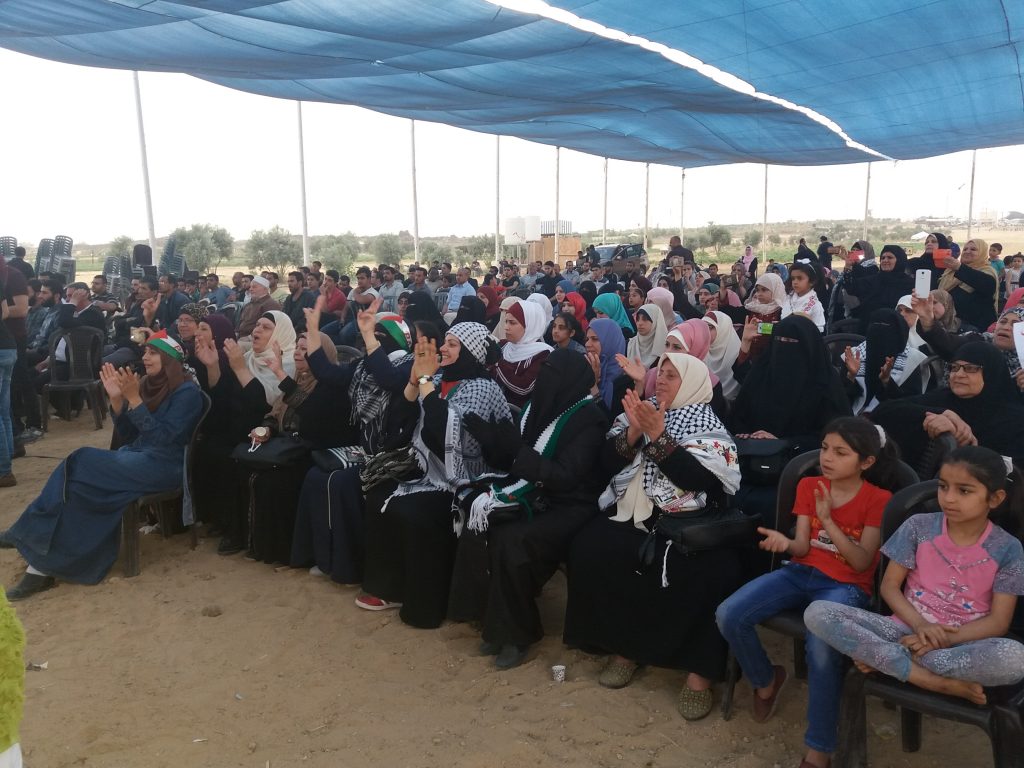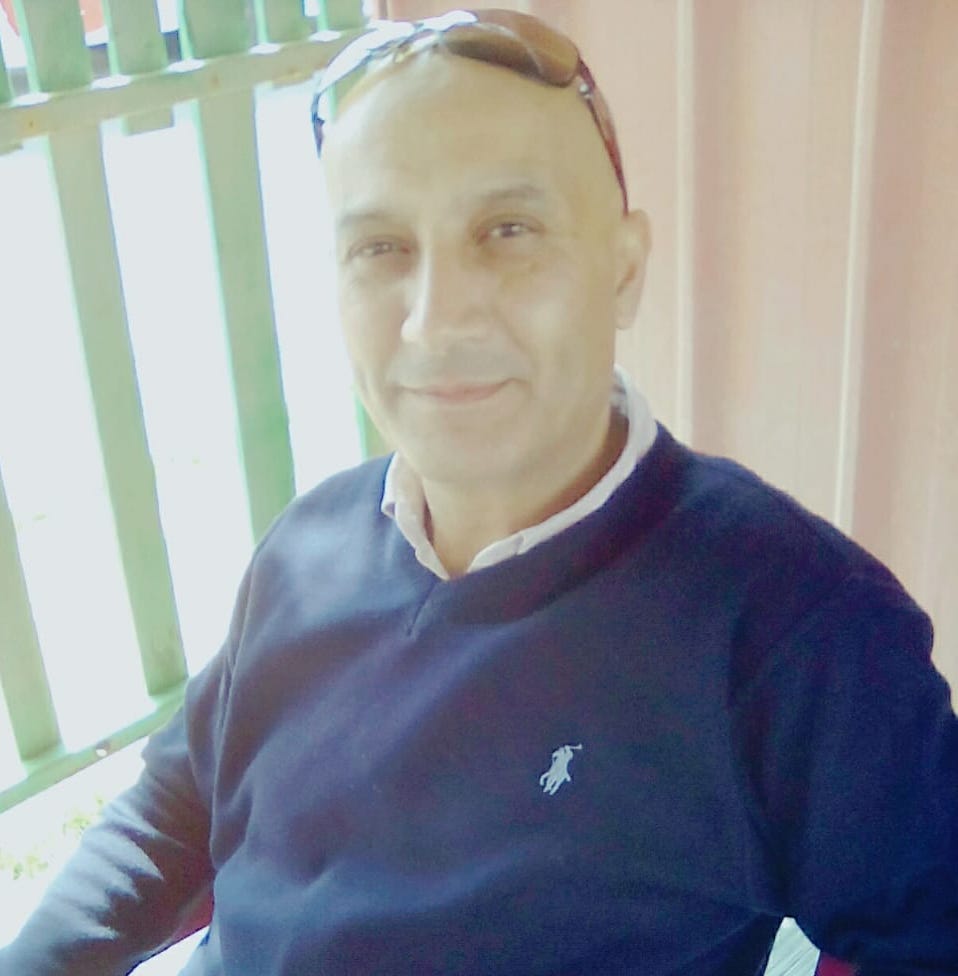Palestinian’s Protest With Art During Gaza’s Great March of Return

“I feel really excited that I am here today, taking part in the Great Return March with my own way, which is poetry.”
A group of Palestinian Dabka folk dancers performed on stage on Thursday May 9, as hundreds of local men, women and children watched and clapped, just about 700 meters from the Israel-Gaza border, east of Gaza city, in an area known as the Mallaka.
The Mallaka area is one of five key gathering spots near the 40-kilometer border fence separating the Gaza Strip from Israel where protesters have been assembling.
Crowds of local Gaza residents have flowed here since the launch of the Great Return March on March 30, 2018. The Dabka dance, known to every Palestinian, is a part of a program of activities arranged by Great Return March organizers.
Among the performances, crowds were also entertained with storytelling, poetry recitals and singing. Afnan Abu Mousa is one of three local poets awarded a special prize by the higher committee of the Great Return March. Under a newly erected plastic sheet-roofed hall, Afnan, a 25-year-old medical student from Gaza City, recited some of her own verses promoting the Palestinian people’s right to return.
“My message goes only to the Zionist occupation; we Palestinians are steadfast in defending our inalienable right of return by all possible means at our disposal, including poetry and writing,” Afnan told Citizen Truth, after having performed on stage.
“I feel really excited that I am here today, taking part in the Great Return March with my own way, which is poetry.” The intermittent cracking of live ammunition being fired by Israeli troops provided a syncopated punctuation to our conversation.
A part of the performances was eight-year-old Mohammad Basiony, whose songs included I am standing on the border fence, with no fear. “I feel very excited, for I am performing for Palestinian crowds in front of the Israeli border fence,” Mohammad told Citizen Truth. “By means of my performance, I would say that we little Palestinians can understand what is meant by Awda, return.” Men and women alike applauded loudly and cheerfully for Mohammad’s impressive voice.

Hundreds of local Palestinian men, women and children watched and clapped for Dabka folk dancers during the Great Return March.
The festivity comes as part of the Culture Palace’s series of activities on Palestinian farmland, just meters from the Israeli border. The Culture Palace is a local non-governmental organization, chaired by Attalah Abuelsebah, a former minister of culture in the Hamas-led government.
“Our presence here constitutes a clear message to the occupiers that Palestinians, who have among them poets, writers, singers and Dabka dancers, protest at the occupation in their own ways,” he told Citizen Truth.
“We are also sending a message of non-violent rejection to the occupation. Our Culture Palace-run activities will continue through the upcoming days, until the 70th anniversary of the Palestinian people’s Nakba on May 15.”
Also in the Mallaka area is an exhibition of portraits and pictures of Palestinian life before the Palestinian Nakba and the creation of the state of Israel in 1948, as well as a political symposium over current political conditions.
Using Non-Violence to Reject Israeli Occupation
Attendees listen attentively while Salah Abdelaati, a prominent rights activist and one of the Great Return March organizers, speaks of the right of return, based on United Nations General Assembly resolution 194, which pertains to Palestinian refugees being allowed to go home to lands they were forced to leave either through violence or fear of violence as the state of Israel was created.
“We have been organizing several activities, including seminars, exhibitions and some other folklore sharing. We have also managed to train 700 youths, male and female, on how to engage in peaceful or non-violent protests,” Abdelaati told Citizen Truth. The march’s organizing committee has arranged many such activities in five centers of protest, all along the length of the Gaza Strip. The committee insists that the Great Return March remains peaceful.
The Great Return March was launched on March 30, 2018, on the 32nd anniversary of Palestinian Land Day, which the Palestinians consider an Israeli government confiscation of vast areas of farmlands from an Arab-Palestinian town, Sakhneen, back in 1976.
Since the Great March Began began, the Israeli army has killed more than 280 Palestinians, wounded nearly 30,000 others, including more than 4,000 by live ammunition, according to the Gaza-based Palestinian health ministry.
Among those wounded, the ministry suggests, 1,942 have injuries in the lower parts of their bodies. About 170 of them have had their limbs amputated.
The United Nations reported somewhat similar statistics to the Palestinian health ministry:
“Between 30 March 2018 and 22 March 2019, 195 Palestinians, including 41 children, were killed by Israeli forces in the “Great March of Return” demonstrations, including during the weekly protests near the perimeter fence, protests against the naval blockade at the beach, and the night activities near the perimeter fence. 28,939 Palestinians were injured, including 25 per cent wounded by live ammunition in these GMR demonstrations. There was one Israeli force fatality and six Israeli force injuries as a result of the demonstrations: outside the GMR demonstrations, one Israeli soldier was killed and another 50 Israelis (three soldiers and 47 civilians) were reported injured by Palestinian armed groups in separate incidents, including rockets fired at southern Israel. In the same period, another 76 Palestinian fatalities resulted from other circumstance, including airstrikes, tank shelling, the opening of fire in the Access Restricted Areas on land and at sea, incidents of attempting to infiltrate into Israel, incursions and land levelling activities. (OCHA Protection of Civilians database). For a comprehensive overview of all Gaza Strip casualties see here.”
As the 71th anniversary of the Palestinian Nakba passed on May 15, Palestinian refugees such as 65-year-old Om Mohammad Mhanna – from the historical Palestinian village of Masmiya – look forward to returning to their homeland.
“I swear, when I have been recently able to travel to occupied East Jerusalem, I felt a great deal of bitterness, just inside me, after having passed by my original village of Masmiya. I hope to remain alive, when the day of return comes,” Om Mohammad told Citizen Truth.















